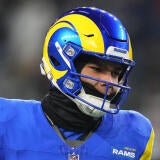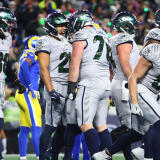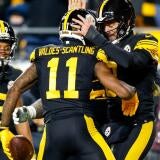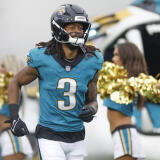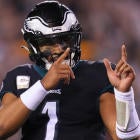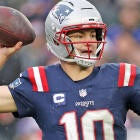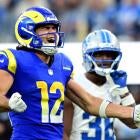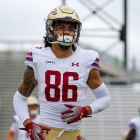Agent's Take: Best team money can buy at 2022 season's end includes Jalen Hurts at QB, Nick Chubb at RB
The end-of-season Ultimate Roster version has 17 holdovers from September, and surprisingly no Bills or Bengals

A 53-man roster under the salary cap using actual cap numbers with certain parameters, which are below, was assembled at the start of the season. The composition of the roster has changed dramatically in this end of the season version because considerable weight was given to 2022 performance.
Tom Brady is no longer the choice at quarterback. His 2022 season was not comparable to his stellar 2021 season. Edge rusher Von Miller and running back Jonathan Taylor were derailed by injuries. Three-time NFL Defensive Player of Year Aaron Donald was also bitten by the injury bug. He had a career low five sacks because of missing the last six games of the regular season with an ankle injury.
Parameters
- 1. The salary cap for the roster is $213.489 million although the actual NFL salary cap is $208.2 million for this year. The number being used is the league's average adjusted salary cap according to NFLPA data. Each NFL team's working salary cap varies largely because unused cap room can be carried over from one year to the next. For example, the Jaguars have the NFL's highest adjusted salary cap at $234.92 million largely thanks to carrying over slightly more than $25.75 million of cap room, which is the most in the league. The Super Bowl LVI champion Rams have the lowest at $201.9 million, which is approximately $6.25 million below the league wide number. Situations like this typically occur when incentives earned during the previous season that weren't counting on the cap get accounted for without sufficient cap room carrying over from the prior year to make up the difference.
- 2. The NFL draft is an essential element of roster building for NFL teams. It is here also. One player from each round of the 2022 draft must be on the roster. This means both Jets first round picks, cornerback Sauce Gardner (fourth overall pick) and wide receiver Garrett Wilson (10th overall pick) can't be selected. The number requirement drops by one player for each year of the preceding three drafts (2019-2021). The limit of one player per round remains. Thus, only four 2019 draft picks are required. There's one other draft pick constraint. Only one 2018 first round pick whose fifth year option was exercised is allowed. Selecting one isn't a necessity.
- 3. The backups at each position are limited to players that aren't clear cut established starters. This means players at positions where there's a "by committee approach," usually running back, qualify. A backfield containing Derrick Henry and Josh Jacobs is prohibited since both are workhorse or every down running backs. Those starting only because of an injury are also fair game as reserves. Young veterans, particularly second year players, solidifying a place in the lineup for the first time this season are no longer allowed to be backups. Rookies can be either starters or backups regardless of actual playing time.
- 4. Choosing a player that was given a franchise or transition designation in 2022 is optional. However, only one player receiving a 2022 designation can be selected.
- 5. There are three starting cornerbacks instead of a traditional base defense (either 3-4 or 4-3) since five or more defensive backs are now used over 60% of the time in the NFL.
Here's the revamped team I assembled with some of my thoughts behind the selections. The 2022 salary cap number for each player is in parentheses. The NFL collective bargaining agreement's $295 daily amount for participating in a team's voluntary offseason workout program is included in the cap numbers when applicable.
In cases where a player was elevated from the practice squad or signed off the street during the season, what would have been his full year cap number is being used. The full cap number is also in use for players traded during the season and when there's a split (lower salary when a player isn't on the 53-man roster) in a contract.
Long range planning wasn't taken into account so worrying about future salary cap obligations, the amount of cap room that could be carried over, expiring contracts and drafting players that might develop into starters down the road wasn't necessary. Different choices would have been made if these aspects had been considerations.
Offensive starters
QB: Jalen Hurts, Eagles ($1,651,195)
A potential franchise quarterback on a rookie contract, like Hurts, is the most valuable commodity in the NFL. The roster flexibility Hurts' cap number provides couldn't be ignored.
Hurts was the leading candidate for NFL MVP until a sprained right shoulder in Week 15's contest against the Bears forced him to miss the next two games, which the Eagles lost. He completed 66.5% of his passes for 3,701 yards with 22 touchdowns and only six interceptions to post a 101.6 passer rating. Hurts added 760 yards on the ground, which was 5th in the NFL among quarterbacks. His 13 rushing touchdowns were tied for league's second most. Patrick Mahomes having the NFL's second largest cap number at $35,793,381 made the choice easy.
RB: Nick Chubb, Browns ($5,216,304)
Chubb gets the nod over Josh Jacobs, who led the NFL in rushing and yards from scrimmage (combined rushing and receiving yards) with 1,653 yards and 2,053 yards, respectively, because of several other strong candidates to be the 2019 first round pick. He was third in the NFL in rushing with 1,525 yards while averaging 5.0 yards per carry. Chubb tied for fifth in the league with 12 rushing touchdowns.
WR: Davante Adams, Raiders ($12.21 million)
Adams posted his second straight season with at least 1,500 receiving yards and 100 receptions. His 14 receiving touchdowns topped the league. Adams set the Raiders single season record for receiving yardage with 1,516 yards. His 15.2 yards per catch were a career best.
WR: Tyreek Hill, Dolphins ($6.485 million)
Hill had a career year during his first season in Miami with 119 catches, 1,719 receiving yards and seven touchdown receptions. He was second in the NFL in both catches and yards. Hill helped transform the Dolphins into the league's most explosive passing offense averaging an NFL best 8.2 yards per pass play. Although Hill is arguably the league's most feared deep threat because of his speed, he'll spend considerable time operating out of the slot. According to Pro Football Focus, 42.1% of Hill's passing snaps were in the slot this season.
WR: Justin Jefferson, Vikings ($3,586.322)
Nobody has ever had a more productive start to an NFL career at wide receiver than Jefferson. 2020's 22nd overall pick has 324 receptions for 4,825 yards and 25 touchdowns during his first three seasons. Jefferson's 128 catches and 1,809 receiving yards not only led the NFL but are the seventh and sixth best single season totals in league history.
TE: Travis Kelce, Chiefs ($8,444,166)
Kelce had one of the finest seasons ever for a tight end. He led NFL tight ends with 110 receptions, 1,338 receiving yards and 12 touchdown catches, which were second in the league. He was the only tight end to hit the 1,000 yard mark.
LT: Trent Williams, 49ers ($9,523,623)
A top flight left tackle on a veteran contract with a cap number under $10 million was a rare commodity this season. The 34-year old Williams isn't showing any signs of slowing down as he continues to be the league's best left tackle.
LG: Joel Bitonio, Browns ($6,658,824)
Bitonio provides one of the NFL's best combinations of run and pass blocking for an offensive guard. He's adept at both. Bitonio allowed just one sack this season.
C: Creed Humphrey, Chiefs ($1,274,260)
Humphrey has quickly entered the league's best center discussion in just two NFL seasons. His low cap number made him an extremely attractive choice. Humphrey didn't allow any sacks and only two quarterback hits this season.
RG: Michael Onwenu, Patriots ($953,877)
Onwenu probably provides the NFL's best value at offensive guard since he's been playing under a four-year rookie contract worth just under $3.5 million. He played the first 15 games before giving up his lone sack of the season.
RT: Lane Johnson, Eagles ($10,911,653)
Johnson continues to be standard at right tackle. 2022 was Johnson's second straight season without surrendering a sack.
Defensive starters
Edge: Myles Garrett, Browns ($12,901,710)
Garrett posted his second straight 16 sack season, which tied his career high. The 16 sacks were also tied for second in the NFL. Garrett's 44 sacks over the last three seasons are the most in the NFL during this span.
DT: Chris Jones, Chiefs ($29,415,666)
Jones is a luxury item that can be afforded because of a quarterback with a low cap number. He has the league's fifth highest cap number for this season. Jones tied a career high with 15.5 sacks. His 77 quarterback pressures (combined sacks, quarterback hurries and quarterback hits) were the fifth most in the NFL and led interior defensive linemen according to PFF.
DT: Dexter Lawrence, Giants ($4,223,251)
Lawrence elevated his level of play by being a force against the run and pass. His 63 quarterback pressures (combined sacks, quarterback hurries and quarterback hits) were the second most in the NFL among interior defensive linemen according to PFF.
Edge: Haason Reddick, Eagles ($3.878 million)
Reddick can make a case that he's already outperformed the three-year, $45 million contract (worth up to $46.5 million through incentives and salary escalators) with $30 million fully guaranteed he received from the Eagles in free agency last March. He set a career high with 16 sacks, which tied for the second most in the league. Reddick tied for the league lead with five forced fumbles and tied for third among defensive players with three fumble recoveries. Lawrence being the 2019 first round pick prevented Nick Bosa, who is considered the favorite to win the NFL Defensive Player of the Year award from being selected.
LB: Micah Parsons, Cowboys ($3,887,376)
Nobody else was seriously considered as the 2021 first round pick for the team. Although the 2021 NFL Defensive Rookie of the Year has been rushing the passer more off the edge this season, he's lining up at linebacker. Parsons, who had 13.5 sacks this season, will get plenty of opportunity to rush the passer from inside and out in addition to playing linebacker.
LB: Bobby Wagner, Rams ($2,507,645)
Wagner demonstrated that there's was plenty of gas left in the tank after the Seahawks released him last March rather than pay him $16.6 million this year on a $20.35 million salary cap number. The Southern California native was intent on coming back home so he joined the Super Bowl LVI champion Rams on a five-year, $50 million contract worth up to $65 million through incentives. Wagner provided his usual presence against the run while posting a career high six sacks this season. He is the only off-ball linebacker this season with more than five sacks and multiple interceptions. This season was Wagner's ninth straight earning first or second team All-Pro honors.
CB: Marlon Humphrey, Ravens (10,282,635)
Humphrey earned Pro Bowl honors for the third time in the last four seasons. There aren't a lot of the better cornerbacks that play on outside but have also spent significant time in the slot like Humphrey.
CB: Jaire Alexander, Packers ($7,076,855)
Alexander picked off five passes and made the Pro Bowl. The Packers holding Justin Jefferson to a career low one catch for 15 yards during Week 17 with Alexander being primarily responsible for him in coverage was impressive.
CB: James Bradberry, Eagles ($2,281,245)
Bradberry joined the Eagles to help form arguably the NFL's best cornerback tandem with Darius Slay after the Giants made him a salary cap casualty last May. Opposing quarterbacks completed 46% of passes (40 of 87 attempts) when targeting Bradberry for a 54.2 passer rating, according to PFF. Bradberry's 17 passes defended were the NFL's third most this season.
Parsons prevented Patrick Surtain II since both are 2021 first round picks. There was never going to a place for Jalen Ramsey thanks to his $23.2 million cap figure.
FS: Kevin Byard, Titans ($7,064,195)
Quite frankly, Minkah Fitzpatrick would have been the choice but Alexander was selected as the 2018 first round pick who had a fifth year option exercised. Byard didn't duplicate his 2021 first team All-Pro performance but still had a Pro Bowl caliber season with four interceptions.
SS: Talanoa Hufanga, 49ers ($894,183)
Hufanga was named first team All-Pro by the Associated Press in his first season as a starter. He provides tremendous value given he's playing under a four-year rookie contract worth a little more than $3.72 million.
Specialists
K: Daniel Carlson-Raiders ($4,241,230)
P: Tommy Townsend-Chiefs ($906,940)
LS: Morgan Cox-Titans ($1,054,580)
KR: Marcus Jones-Patriots ($945,408)
PR: Jones
Carlson gets the nod because of some uncharacteristic misses by Justin Tucker, the most accurate kicker in NFL history. He led the NFL by connecting on 91.9% of his field goal attempts (34 of 37) and missed only one of his 36 extra point tries. Carlson set a single season NFL record with 11 made field goals of 50 yards or more. Townsend had an NFL best 45.6 yard net punting average. Jones handles return duties. He led the NFL with 12.5 yards per punt return. He also averaged 23.9 yards per kickoff return. Cox was named to his fifth Pro Bowl as the AFC's long snapper.
Reserves
QB: Brock Purdy, 49ers ($726,621)
The 49ers haven't missed a beat since Purdy, the last pick in the 2022 draft, was pressed into action when Jimmy Garoppolo broke his left foot against the Dolphins in Week 13. In five games as a starter, all 49ers wins, Purdy completed 68.5% of passes (85 of 124 attempts) for 1,098 yards with 11 touchdowns and two interceptions. Purdy had the league's best passer rating over the last five weeks of the season at 119.0.
RB: Tony Pollard, Cowboys ($1,140,547)
RB: Rhamondre Stevenson, Patriots ($1,020,230)
RB: Dameon Pierce, Texans ($911,966)
RB: Kyle Juszczyk, 49ers ($2,960,815)
Pollard was the Cowboys' most effective and consistent running back. He was named to the Pro Bowl for the first time during his first 1,000 rushing yard season in which he averaged 5.2 yards per carry. Damien Harris' hamstring injury opened the door for Stevenson to also top the 1,000 rushing yard mark while averaging 5.0 yards per carry. Pierce was going to easily rush for more than 1,000 yards before missing the last four games with a left ankle sprain. He was 61 yards shy of the mark. Pollard and Stevenson will both be utilized as the third down back. Juszczyk is the NFL's highest paid fullback at $5.4 million per year. He led all fullbacks in receptions (19) and was second in offensive playtime (47.45%).
WR: Garrett Wilson, Jets ($3,793,756)
WR: Kalif Raymond, Lions ($1.975 million)
WR: Rashid Shaheed, Saints ($723,996)
Wilson is a leading candidate for NFL Offensive Rookie of Year. He had 83 catches for 1,103 yards without consistent quarterback play. Raymond's opportunities were supposed to be more limited than in 2021 with the arrival of D.J. Chark in free agency. Chark missing six games with a left ankle injury helped put Raymond in a position to catch 47 passes for 616 yards. He's also an option as a return man. Shaheed didn't start getting meaningful playtime until Michael Thomas had season ending toe surgery. The 2022 undrafted free agent averaged 17.2 yard per catch, which was the second best mark in the NFL.
TE: Austin Hooper, Titans ($2,699,145)
TE: Josh Oliver, Ravens ($1,084,100)
Hooper, who was part of the three-man tight end rotation in Tennessee's run oriented offense, was second on the team with 41 receptions. Oliver has gotten praise from Ravens head coach John Harbaugh for his improving blocking. His primary function is as a blocker.
OL: Patrick Mekari, Ravens ($3,109,145)
OL: Cameron Fleming, Broncos ($1,047,500)
OL: Matt Hennessey, Falcons ($1,303,033)
OL: Ben Bredeson, Giants ($904,440)
The offensive line depth is a mix of experience and youth. Fleming was the true definition of a swing tackle. Injuries to left tackle Garett Bolles and right tackle Billy Turner forced Fleming to see get significant action on both sides of the offensive line. Mekari can play all five offensive line positions but has spent most of his time at tackle the last couple of seasons. Bredeson hasn't reclaimed his starting left guard job since injuring his right knee in Week 7 versus the Jaguars. He's been splitting time with Nick Gates after returning to action in Week 15. Hennessey lost a training camp battle with 2021 fourth round pick Drew Dahlman to remain Atlanta's starting center. He filled in capably at left guard this season.
EDGE: Brandon Graham, Eagles ($9.413 Million)
EDGE: Justin Houston, Ravens ($3.5 Million)
The minimal financial commitment at quarterback is allowing for a bigger than usual investment in pass rush depth. Graham had a career high 11 sacks in a deep Eagles defensive line rotation despite only being on the field for 42.86% of Philadelphia's defensive snaps. Houston had 9.5 sacks as a situational pass rusher.
DT: Morgan Fox, Chargers ($1,051,040)
DT: Khyiris Tonga, Vikings ($825,000)
Fox saw more action than anticipated because of injuries to the Chargers' defensive line. He had a career high 6.5 sacks this season. Tonga is strictly a run stuffer.
LB: Alex Singleton, Broncos ($1,124,470)
LB: Monty Rice, Titans ($1,110,863)
LB: E.J. Speed, Colts ($1,044,429)
LB: Malcolm Rodriguez-Lions ($755,682)
LB: Jack Sanborn-Bears ($711,052)
The Broncos didn't expect for Singleton to be fifth in the league with 163 tackles when signing him to a one-year, $1.15 million deal worth up to $1.865 million through incentives. Jonas Griffith's season ending foot injury paved the way for Singleton to become a fixture in the starting lineup midway through the season. Rice, Rodriguez, Sanborn and Speed's primary contributions will be on special teams. Rodriguez earned a starting job with the Lions in training camp. Sanborn was a tackling machine after being inserted to Chicago's starting lineup with Roquan Smith getting dealt to the Ravens right before the November trading deadline.
CB: Tariq Woolen, Seahawks ($790,866)
CB: Marcus Jones, Patriots ($945,408)
CB: Kader Kohou, Dolphins (718,552)
Woolen earned Pro Bowl honors with six interceptions, which tied for the NFL lead. Sauce Gardner was omitted because there was more value in having Garrett Wilson as a wide receiver because of Woolen. Jones will make his mark returning kicks although he returned one of his two interceptions for a touchdown. Kohou, a 2022 undrafted free agent, was a pleasant surprise for Miami particularly from the slot.
S: Jalen Pitre, Texans ($1,631,927)
S: Ryan Neal, Seahawks ($902,965)
Pitre led all rookies with 147 tackles. Woolen was the only rookie who had more than Pitre's five interceptions. Neal was arguably Seattle's best defensive player replacing Jamal Adams, who tore a quadriceps tendon in the season opener.
Tale Of The Tape
- Total salary cap room used (53 Players): $205,402,283
- Remaining salary cap room: $8,086,717
- Offense (25 Players): $90,261,518
- Defense (25 Players): $108,938,015
- Specialists (3 Players): $6,202,750
Positional salary breakdown
(Salary cap percentage in parentheses)
QB: $2,377,816 (1.11%)
RB: $11,249,862 (5.27%)
WR: $28,720,074 (13.45%)
TE: $12,227,411 (5.73%)
OL: $35,686,355 (16.72%)
DE: $29,692,710 (13.91%)
DT: $35,514,957 (16.64%)
LB: $11,141,517 (5.22%)
CB: $22,095,561 (10.35%)
S: $10,493,270 (4.92%)
Final thoughts
All of the cap room isn't being used. There's about $4.5 million to spare after accounting for a full practice squad of 16 players (approximately $3.5 million). That's a result of the tremendous advantage gained from selecting Hurts and Purdy, who are both on rookie contracts, at quarterback.
There is a greater allocation of cap resources to the defense, which isn't a surprise because of the small cap expenditure at quarterback. Slightly more than 47% of the available cap space is devoted to the offensive and defensive lines, which is consistent with a starting in the trenches philosophy.
There are 17 holdovers from the original 2022 team. The most continuity is on the offensive line. Four starters were originally selected (Bitonio, Humphrey, Onwenu and Williams). The starting linebackers also didn't change (Parsons and Wagner).
The Eagles lead the way with five players. The Chiefs, 49ers and Titans are next with four players each. Surprisingly, the Bengals and Bills, two of the AFC's leading Super Bowl contenders, aren't represented. The Buccaneers, Cardinals, Commanders, Panthers and Steelers were also shut out.

